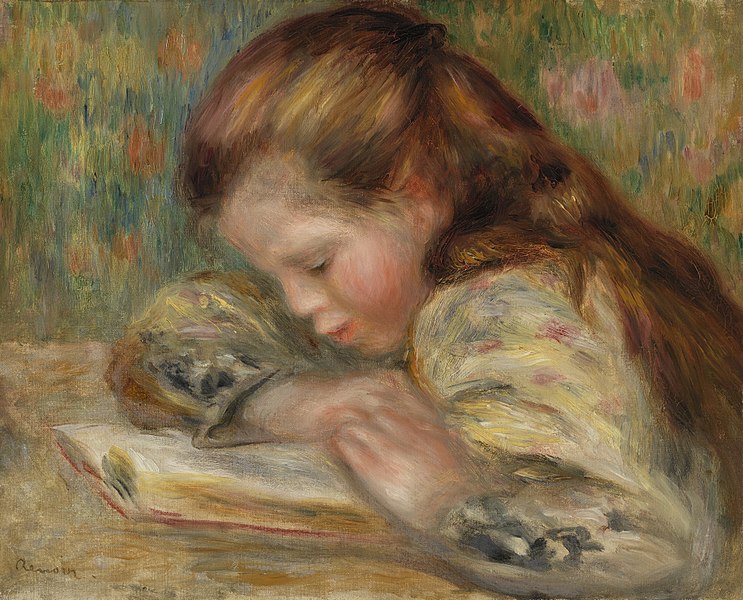Last year, I would show my then five-year-old son the letters “T-I-N” and he would say, “ITS!”
This year, I show my now six-year-old son the letters “T-I-N” and he says, “Tuh, Ih, Nuh. TuhhhhhhhhIhhhhhhNuh.” Then he looks at me for a second, brow furrowed. “TIN!” He shouts. “TIN!”
His cup of self-confidence runneth over: He can read!
What makes this miracle happen, this awakening to the queer and quixotic relationship between concept, symbol, and sound? For this particular little loveable scamp, a boy whose pockets are full of rocks and sticks and yet whose heart and mind run deep with thoughts on God and Man, it was an additional year of growth, a lot of hearty play, and a patient parent holding him close while they looked through Noah Webster’s simple blue-backed speller and drew on a small white board with dry erase markers.
This is what my third child needed in order to learn to read. Yet of the many factors going into this process, the only one that anyone ever seems to talk about is the one represented by Webster’s speller: the curriculum (in this case, one based on phonics).
Debates over phonics and its methodological nemeses, “cueing,” workshop-based, and whole-language-based methods, have been back in the news lately in another development of the so-called Reading Wars. The Reading Wars, the national conflict over how to teach children—notice that this is different from the question of what children need in order to learn—to read, have just been revived through the bombshell announcement that Teacher’s College, Columbia University is closing down its Lucy Calkins program, whose reading approach was used by about 16% of public schools in recent years. Other popular reading programs in public schools have followed similar, phonetics-unfriendly approaches (as Education Week reports here), which may be contributing to declining reading competency rates at the fourth-grade level.
If you’ve ever watched a child studying reading through one of these methods, you may have noticed that there is a lot of guessing involved based on context and image cues. Such cues can certainly be helpful to emerging readers, but without adequate instruction in the sounds that letters and combinations of letters usually make in English, a reading approach that relies heavily on these can result in order children who can more or less figure sentences out but cannot read fluidly, easily, or speedily. For many of these kids, reading remains a chore—although they can read, reading never becomes easy. It remains instead something that stands in between the child and a story, and so they do not come to love or embrace it as a pastime.
I sometimes suspect that just such a hidden lack of facility with reading underlies many college students’ increasingly low threshold of tolerance for reading assignments. When I first started teaching young adults over a decade ago, I got complaints for assigning 150 pages in a week to upperclassmen. But nowadays, I sometimes hear students complaining about twenty-five.
Twenty-five!
If both reading assessments and experience are correct, and many young people are not in fact learning to read well, then why has it taken so long for Schools of Education and school administrators to change their ways? If phonics works better than cueing and guessing, why didn’t we return to phonics after a few years?
That is question I cannot an$wer, except to $ay that I don’t think it ha$ much to do with actual re$earch. If it were about research, we’d be following Sweden’s lead in returning to textbooks and Finland’s lead in making education before age seven largely about outdoor play. We’d be encouraging parents to prioritize getting their children adequate sleep most nights, for heaven’s sake.
The children really do need more sleep.
But getting back to my experiences teaching my own children, let me suggest that part of the answer to the reading conundrum may lie in how we frame the question. Are we asking what curriculum we should use to teach reading, or what children need in order to learn to read (including curriculum, but also so much more than that)? Overall, I think we have lately been ignoring the reality that many different factors go into turning the process of learning to read from an exchange—or even a battle or war—in which a very small child, often as young as four or five, is expected to be able to master academic skills prematurely on pain of being labelled “behind,” into a personal, relational experience which takes into account who and how young children generally are and what might actually help them learn. That should probably include a phonics-based curriculum, but that is only part of what is needed.
Why do the Finns emphasize outdoor play so much in the early school years? Well, there are cultural reasons and reasons attached to research findings, but one thing we might all take note of is that a child cannot write with his hand if he has to support himself on his elbow while sitting. If a child has not developed adequate core strength from large-motor activity to support his torso without using the table for support, his arm cannot move freely, and he cannot write. Nor can he read if he cannot keep his head and torso steady while looking at a book.
So more hours of outdoor play will likely be of much more help to the six-year-old who is struggling to read or write than extra hours painstakingly moving his pencil or staring at tiny letters on a page.
Why does my third child, my little son whom I mention above, need me to be in physical contact with him while he reads? Because it helps him feel warm and safe, I imagine, and so he is not as afraid of making mistakes. Alternative educators recognized this in the classroom decades ago: that children read better with an adult’s arm around them, or while piled onto soft pillows with a couple of friends.
When my first child, a girl, wasn’t learning to read at age five or six, I knew from my reading that contra what most American normative schools would say, I should not be alarmed. But as time went on, I learned that she had problems with her eyes not converging properly, and once that was addressed through vision therapy, she learned to read easily at age seven, using large, colorful reading books that attracted her and some basic phonetic instruction.
If she had been in a Reading Wars-influenced classroom, she might well have just been considered behind (read: dumb). Where would her self-confidence be after such an experience? Not bubbling over, that’s for sure.
My second child, on the other hand, learned to read at a nice, comfortable pace during his kindergarten and first grade years, slowly and steadily, like the tortoise, with Noah Webster and his mom and dad, to help him. Today, in fourth grade, he reads happily.
My fourth child is only three but seems to be learning to read and write right along with her older brother, as she is ready for it and is very interested. Splendid. Why not, if she is ready?
All children are different, of course, and children can learn to read in a classroom just as well as in a homeschool environment like my children’s. But instead of paying attention to the screeds of the Reading Wars, I wish we would pay more attention to how children learn best in general. We do not allow teachers to touch children in our schools anymore, for fear of abuse; so kids can’t have the comforting contact that might help a struggling reader feel safe making mistakes. We cut P.E. and recess, so kids are jittery and weak and can’t concentrate in class. We don’t allow teachers, by and large, to choose their own curricula, so those who know what children need have to try to fit phonics in around the required whole-language nonsense. We make decisions based on noise, lobbying, and marketing, rather than on actual research and experience.
So I am glad to see movement back toward phonics in schools, as this approach has served children well for a very long time. But I hope that at some point we will be able to go even farther in our reforms and provide children with the warmth, safety, and patience that they also need in order to learn to read at three, four, five, six, seven, eight, or nine years old without any shame and with freedom and facility. I’m encouraged to see that not only homeschooling, but also microschools and classical schools and alternative schools are all growing in our country, offering parents and teachers the opportunity to respond to the needs of students in these ways, too. These are all better alternatives the drama of the Reading Wars, which seems to ignore the fact that children are the main casualties of our self-centered behavior.
Image credit: “Child Reading” by Renoir






3 comments
Dixie
Thanks for this point about literacy instruction, Elizabeth! I didn’t intend for the aside in my essay to suggest that I would attribute declining literacy in college solely to changes in instruction; I didn’t have time or space to address the questions fully here, of course.
You’re quite right that this has been a long-term problem and debate with many factors involved, although I don’t think admissions policies are at fault in the case of my own institution. I would cite factors such as the decline in reading assignments in lower schools, the pandemic school environment/lockdown schooling, the rise in texting/social media rather than in-person conversation, declining writing instruction, etc. along with poor reading instruction.
Martin
I saw problems with cueing and guessing 15 years ago when I taught writing to first year students at a university considered one tier below ivies. The cohort was born around 1990 and had been taught to guess a word from the first 2 or 3 letters — a purely visual approach not so far removed from learning to read Chinese.
One day I decided to have the class take turns each reading a paragraph from an instructional essay we were covering. Many of them stumbled at words that had more than 3 syllables — I quickly realized that they were guessing (like a crude crowd sourcing algorithm) the most likely word from the first few letters.
Apparently, this was pushed on young kids in the 1990s as a way to accelerate reading skills — flash cards, guessing, etc. in an era that insisted on competitiveness (the capitalist swing of the pendulum before wokeness) and deemed kids “behind” if they couldn’t read simple words by the time they entered kindergarten.
Elizabeth Nolan
I retired in 2023 after teaching for 40 years. For twenty-four of those years, I taught First Grade, thus keeping company with approximately 600 children who were learning to read. Some children entered the classroom reading fluently and often, but not always, their spelling skills were similarly advanced. Those students did not need phonics instruction in the same way as children still struggling to learn the alphabet and sound-symbol correspondence. Each of these points on the spectrum of literacy development were normal. It is to be expected that some six-year-olds read and some are still on their way. This phenomenon is due in part to each student’s predilections. The “non-readers” typically excelled in other pursuits because they had dedicated time in their young lives to what interested them – visual arts, block-building, athletics, dramatic play, etc., while the readers had shown an interest in books from their toddler years. The fact that parents and the institution (i.e., school) now expected the non-readers to read skillfully and at grade level within a year was in some ways humorous. Nevertheless, for most beginning readers, learning to read is actually enjoyable. Dixie Dillon Lane is absolutely on target, though, with promoting outdoor play and adequate sleep as essential for the physical health of the child and that core strength is related to the child’s capacity to read. That is, reading is not just about vision. Finally, it is ahistorical to attribute today’s crisis in literacy to a “dumbing down” of literacy instruction. In fact, the theorists circa 1990 were responding to the same crisis we have now. Why Johnny Can’t Read and Why Joanie Won’t Read are not new problems. Why students at a reputable university lacked skills in basic writing may be attributable to admissions policies that made it easier to matriculate.
Comments are closed.